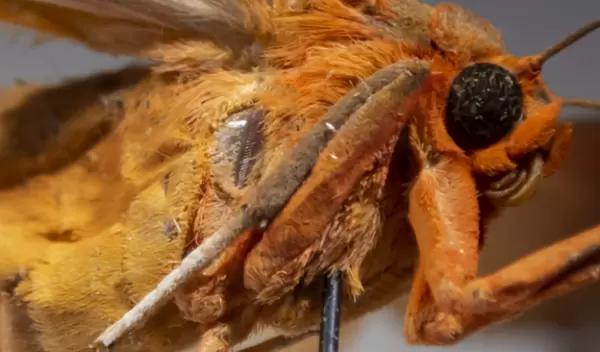
Moths enlist additional troops in an evolutionary arms race
While a clear night sky might seem quiet and peaceful to us, empty of everything but stars, this nocturnal world is filled with a high-pitched cacophony of sound just beyond our ability to hear. Bats pierce the shadows with ultrasonic pulses that enable them to construct an auditory map of their surroundings, bad news for moths, one of their favorite foods.
Not all moths are defenseless prey, however. Some emit ultrasonic signals of their own that startle bats into breaking off pursuit. Many moths that contain bitter toxins avoid capture altogether by producing distinct sounds that alert bats to their foul taste. Others conceal themselves in a shroud of sonar-jamming static that hinders bats' ability to find them with echolocation (locating them with reflected sound).
These types of auditory defense mechanisms in moths were considered relatively rare, known only in tiger moths, hawk moths and a single species of geometrid moth. But a U.S. National Science Foundation-supported study published in the journal PNAS shows that ultrasound-producing moths are far more widespread than previously thought, adding three newly discovered sound-producing organs, eight new subfamilies and potentially thousands of species to the roster.
"It's not just tiger moths and hawk moths that are doing this. There are tons of moths that create ultrasonic sounds, and we hardly know anything about them," said senior author Akito Kawahara, a curator at the Florida Museum of Natural History.
The researchers were also interested in understanding how these sounds might converge between moth species. In the same way that nontoxic butterflies mimic the colors and wing patterns of less savory species, moths that lack the benefit of built-in toxins can copy the pitch and timbre of genuinely unappetizing relatives.
After collecting and studying thousands of moths for over a decade in Ecuador, French Guiana, Mozambique and Malaysian Borneo, the researchers spent a final two weeks in Ecuador, where they recorded the alarm calls of every moth they could catch. Afterward, they analyzed these recordings with the help of a theoretical physicist and a machine learning algorithm that scrutinized each note, looking for similarities.
The program revealed what, until now, other researchers had only guessed at: Moth species don't act like individual composers, each with their own unique calling card and distinct style. Instead, a small number of moths derive their own scores, which other moths seem to replicate in complex acoustic mimicry rings.
Lead author Jesse Barber, a biologist at Boise State University, says more work is needed to uncover the exact nature of these sounds, but he suspects the trailblazing moths at the center of these rings are likely noxious, while the copycats at the fringes are merely false advertisers. "If these results pan out, it will likely be the largest set of mimicry complexes on Earth," he said.
Added Jodie Jawor, a program director in NSF's Division of Integrative Organismal Systems, "Results like these not only help us understand the amazing complexity and diversity in animal behavior, but also set the stage for the development of technologies that humans may use."


